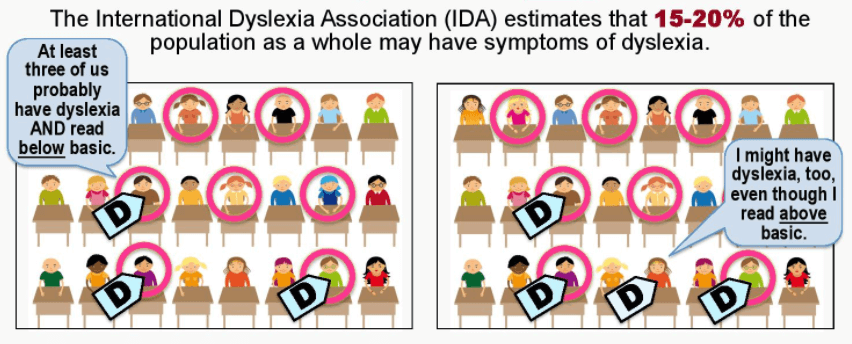Legislature blows chance to help California kids with dyslexia

Is California really trying to help all kids read?
Dyslexia is the most common cause of difficulties in reading, writing and spelling. Unfortunately, it often goes undetected and therefore unaddressed in early grades, leading to more complex learning challenges later. This year, a bill that would require educators to screen students for risk of dyslexia sailed through the Senate. There was no vote in opposition.
However, when the bill got to the Assembly, the head of the education committee refused to hold a hearing. The result? No further action on the bill this year. Senator Portantino, the author of the bill, SB 237, blasted the delay in a press release.
“Despite unprecedented public support for dyslexia screening, the Assembly Education Committee has refused to set the bill for consideration. Clearly, California should be doing more to better serve our students in need. Tabling this bill is not just out of touch with the needs of our families and the overwhelming support of Californians, it also does a disservice to the legislative and deliberative process.”
Sponsored by Decoding Dyslexia and Edvoice, the bill had a long list of supporters including literacy and education experts such as the American Academy of Pediatrics (California), the California Association of School Psychologists and the California Federation of Teachers. It was a high priority issue for the California State PTA and despite outreach by PTA parents asking that the bill be heard, it was not scheduled.
The California Teachers Association notified the Education Committee that it opposed the bill in late June, after unsuccessfully seeking amendments in meetings with the sponsors and the author’s staff. The CTA felt the bill was unnecessary, leads to overidentifying dyslexia in young students, mandates more testing and jeopardizes limited instructional time. Also opposing the bill were the California School Boards Association and Californians Together.
What is dyslexia?
What is dyslexia? Dyslexia is a learning disorder that involves difficulty reading due to problems identifying speech sounds and learning how they relate to letters and words (decoding). Dyslexia affects areas of the brain that process language. (Source: Mayo Clinic)
What dyslexia is not: Dyslexia isn’t a problem of intelligence, laziness, vision, or reading letters backwards. It is not related to poverty or ethnicity or gender. It is nearly equally distributed throughout the population. It is somewhat more common among boys than girls.
How does screening for the risk of dyslexia work?
Don’t get confused. Screening for risk of dyslexia is very different from identifying or diagnosing dyslexia. Screening takes just a few minutes, and is used for all students in a class.
According to the National Center on Improving Literacy, “Screening determines the level of risk for reading problems in general and the potential risk of having or developing dyslexia. It is not appropriate to use screening results to formally diagnose whether an individual actually has dyslexia.”
Diagnosis of dyslexia is a more lengthy process. It’s an appropriate next step for students with high levels of risk demonstrated by screening results, or who have not responded adequately to generally effective early reading intervention, or both.
Why screening for dyslexia is important
Teachers use all kinds of measures at the beginning of the school year to help determine the needs of each student and adjust teaching accordingly. Many states require screening all students for the risk of dyslexia in order to take early action. California does not, even though dyslexia is the most common cause of difficulties in reading, writing and spelling.
Let me repeat that. Dyslexia is the most common cause of problems in reading. Unlike many states, California does not require schools to screen for risk of dyslexia. Many educators may do it anyway, but it isn’t required.
According to the International Dyslexia Association, about 15-20% of the population may have symptoms of dyslexia and struggle to read. Every school has children at risk of dyslexia. It can be difficult to spot because some may be reading below basic level and some may be reading above basic levels.

Failure to identify and support struggling students is a frequent parent complaint, and litigation about it has become common and expensive. On July 23, 2021, for example, Berkeley Unified School District notified parents that it had entered into a Settlement Agreement to avoid the burden, expense, and uncertainties of continued litigation. The provisions of the settlement include adopting a literacy improvement plan that includes “universal screening and progress monitoring of reading growth to promote timely evaluation and identification of students at risk for reading disabilities.”
Opposition to screening? Nope.
Is there professional disagreement about screening for risk of dyslexia? Nope.
The National Center on Improving Literacy says “there is broad agreement that schools should implement early screening (e.g. as early as preschool and kindergarten) and intervention programs. It is of paramount importance that states, districts, and schools take action to improve services for students with dyslexia, which begins with efforts at early screening and preventative intervention.”
The International Dyslexia Association agrees. “Research has shown that brain plasticity decreases through childhood. It takes four times as long to intervene in fourth grade as it does in late kindergarten… because of brain development and because of the increase in content for students to learn as they grow older. Children at risk for reading failure can be reliably identified even before kindergarten.“
The California Dyslexia Guidelines also concur: “One of the greatest contributing factors to lower achievement scores in reading is the lack of early and accurate identification of students with dyslexia.”
What are the risks of failing to identify dyslexia?
Refusing to hear this bill is a big deal. Right now, thousands of students are not properly screened for this learning risk. According to the Mayo Clinic, dyslexia causes students to face many serious challenges.
|
Challenges of dyslexia according to the Mayo Clinic |
|
|---|---|
|
Trouble learning. |
Because reading is a skill basic to most other school subjects, a child with dyslexia is at a disadvantage in most classes and may have trouble keeping up with peers. |
|
Social problems. |
Left untreated, dyslexia may lead to low self-esteem, behavior problems, anxiety, aggression, and withdrawal from friends, parents and teachers. |
|
Problems as adults. |
The inability to read and comprehend can prevent a child from reaching his or her potential as the child grows up. This can have long-term educational, social and economic consequences. |
Prisons require screening for risk of dyslexia. California public schools do not.
Dyslexia is closely associated with the school to prison pipeline.
Research indicates, for example, that 80% of prison inmates in Texas are functionally illiterate and 48% have dyslexia. This is such a prison crisis that Congress passed the First Step Act in 2018 that requires all federal prison inmates to be screened for dyslexia.
Can students with dyslexia overcome it?
Dyslexia makes it harder to read and write, but there are many prominent examples of highly successful people with dyslexia, including: Thomas Edison, Leonardo Di Vinci, Alexander Graham Bell, Auguste Rodin, Walt Disney, Stephen Spielberg, F. Scott Fitzgerald, Charles Schwab, Cher, Whoopi Goldberg, Tommy Hilfiger, and Gavin Newsom.
Where is the bill now?
By failing to schedule a hearing in the Assembly Education Committee, no further action can be taken in 2021. No hearing. No screening for risk of dyslexia. It was a stunning and unexpected treatment of a bill that addresses many parent concerns. It is now a two year bill and can be acted on in early 2022.
What do you think?
- Does your school screen for risk of dyslexia?
- Should California require schools to screen all students for the risk of dyslexia?
- Should the chair of the Education Committee have the power to decide which bills will be heard in committee?
- If so, should there be limits to this power? For example, should the chair have the power to refuse to hear a bill even if most of the members of the committee support the bill and want it to be heard?
Tags on this post
All Tags
A-G requirements Absences Accountability Accreditation Achievement gap Administrators After school Algebra API Arts Assessment At-risk students Attendance Beacon links Bilingual education Bonds Brain Brown Act Budgets Bullying Burbank Business Career Carol Dweck Categorical funds Catholic schools Certification CHAMP Change Character Education Chart Charter schools Civics Class size CMOs Collective bargaining College Common core Community schools Contest Continuous Improvement Cost of education Counselors Creativity Crossword CSBA CTA Dashboard Data Dialogue District boundaries Districts Diversity Drawing DREAM Act Dyslexia EACH Early childhood Economic growth EdPrezi EdSource EdTech Education foundations Effort Election English learners Equity ESSA Ethnic studies Ethnic studies Evaluation rubric Expanded Learning Facilities Fake News Federal Federal policy Funding Gifted Graduation rates Grit Health Help Wanted History Home schools Homeless students Homework Hours of opportunity Humanities Independence Day Indignation Infrastructure Initiatives International Jargon Khan Academy Kindergarten LCAP LCFF Leaderboard Leadership Learning Litigation Lobbyists Local control Local funding Local governance Lottery Magnet schools Map Math Media Mental Health Mindfulness Mindset Myth Myths NAEP National comparisons NCLB Nutrition Pandemic Parcel taxes Parent Engagement Parent Leader Guide Parents peanut butter Pedagogy Pensions personalized Philanthropy PISA Planning Policy Politics population Poverty Preschool Prezi Private schools Prize Project-based learning Prop 13 Prop 98 Property taxes PTA Purpose of education puzzle Quality Race Rating Schools Reading Recruiting teachers Reform Religious education Religious schools Research Retaining teachers Rigor School board School choice School Climate School Closures Science Serrano vs Priest Sex Ed Site Map Sleep Social-emotional learning Song Special ed Spending SPSA Standards Strike STRS Student motivation Student voice Success Suicide Summer Superintendent Suspensions Talent Teacher pay Teacher shortage Teachers Technology Technology in education Template Test scores Tests Time in school Time on task Trump Undocumented Unions Universal education Vaccination Values Vaping Video Volunteering Volunteers Vote Vouchers Winners Year in ReviewSharing is caring!
Password Reset
Search all lesson and blog content here.
Login with Email
We will send your Login Link to your email
address. Click on the link and you will be
logged into Ed100. No more passwords to
remember!














Questions & Comments
To comment or reply, please sign in .
Frida August 14, 2021 at 7:42 pm
Carol Kocivar August 20, 2021 at 5:57 pm
enangriffin August 4, 2021 at 2:58 pm
Wendy Wolfson August 3, 2021 at 12:13 pm
Carol Kocivar August 5, 2021 at 12:29 am